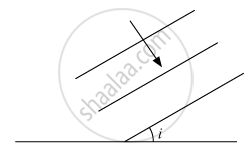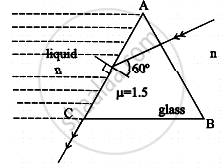Advertisements
Advertisements
प्रश्न
Explain how Corpuscular theory predicts the speed of light in a medium, say, water, to be greater than the speed of light in vacuum. Is the prediction confirmed by experimental determination of the speed of light in water? If not, which alternative picture of light is consistent with the experiment?
उत्तर
No; Wave theory
Newton’s corpuscular theory of light states that when light corpuscles strike the interface of two media from a rarer (air) to a denser (water) medium, the particles experience forces of attraction normal to the surface. Hence, the normal component of velocity increases while the component along the surface remains unchanged.
Hence, we can write the expression:
c sin i = v sin r ...........(i)
Where,
i = Angle of incidence
r = Angle of reflection
c = Velocity of light in air
v = Velocity of light in water
We have the relation for a relative refractive index of water with respect to air as:
μ = `"v"/"c"`
Hence, equation (i) reduces to
`"v"/"c" = sin"i"/sin "r" = μ` ..........(ii)
But, μ > 1
Hence, it can be inferred from equation (ii) that v > c. This is not possible since this prediction is opposite to the experimental results of c > v.
The wave picture of light is consistent with the experimental results.
APPEARS IN
संबंधित प्रश्न
The refractive index of glass is 1.5. What is the speed of light in glass? (Speed of light in vacuum is 3.0 × 108 m s−1)
Is the speed of light in glass independent of the colour of light? If not, which of the two colours red and violet travels slower in a glass prism?
Let us list some of the factors, which could possibly influence the speed of wave propagation:
(i) Nature of the source
(ii) Direction of propagation
(iii) Motion of the source and/or observer
(iv) Wavelength
(v) Intensity of the wave
On which of these factors, if any, does the speed of light in vacuum?
A plane wavefront propagating in a medium of refractive index 'μ1' is incident on a plane surface making the angle of incidence 'i' as shown in the figure. It enters into a medium of refractive index 'μ2' (μ2 > μ1). Use Huygens' construction of secondary wavelets to trace the propagation of the refracted wavefront. Hence verify Snell's law of refraction.

The wavefronts of a light wave travelling in vacuum are given by x + y + z = c. The angle made by the direction of propagation of light with the X-axis is _________ .
The wavefronts of light coming from a distant source of unknown shape are nearly _________ .
Light waves travel from optically rarer medium to optically denser medium. Its velocity decreases bec;ause of change in ______.
In the figure, the optical fibre is l = 2 m long and has a diameter of d = 20 µm. If a ray of light is incident on one end of the fiber at angle θ1 = 40°, the number of reflections it makes before emerging from the other end is close to ______.
(Refractive index of fiber is 1.31 and sin40° = 0.64)

A glass slab of thickness 4 cm contains the same number of waves as 5 cm of water. When both are traversed by the same monochromatic light. If the refractive index of water is `(4/3)`. What is that of glass?
In the given figure, the face AC of the equilateral prism is immersed in a liquid of refractive index 'n'. For incident angle 60° at the side AC, the refracted light just grazes along face AC. The refractive index of the liquid n = `sqrtx/4`. The value of x is ______.
(Given refractive index of glass = 1.5)

White light is an incident at 20° on a material of silicate flint glass slab as shown. `μ_"violet"` = 1.66 and µr = 1.6. For what value of d will the separation be 1 mm in red and violet rays?

A light ray in a medium (RI = 5/3) enters another medium at an angle of 30°. The angle in the other medium is sin-1 (5/6). The incident angle must be increased such that the ray is completely reflected at minimum degrees is ______.
Using Huygens’s construction of secondary wavelets draw a diagram showing the passage of a plane wavefront from a denser to a rarer medium. Using it verifies Snell’s law.
